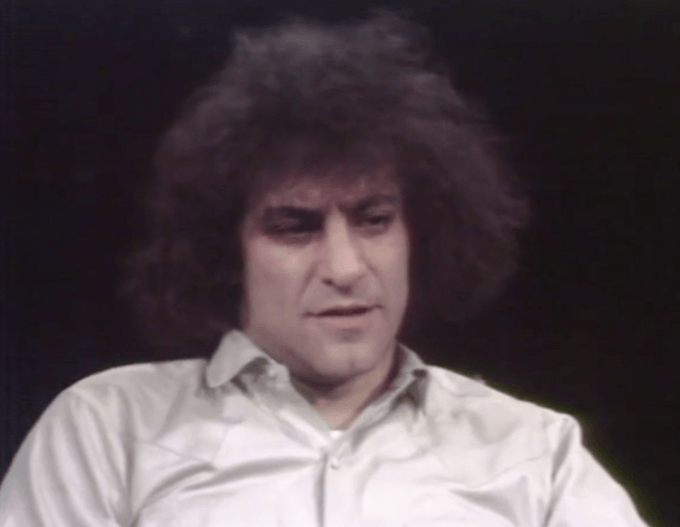
Abbie Hoffman, Chicago Conspiracy Eight.
In January 1970, R.G. Davis, the founder of the San Francisco Mime Troupe and one of the fathers of guerrilla theater, filmed a 60-minute video with seven of the defendants in the Chicago Conspiracy Trial. Long buried, the film which is titled “Chicago Conspiracy Eight,” recently surfaced thanks to the Media Burn Archive. Unedited and uninterrupted, it can be viewed on Vimeo.
According to the web site, the Media Burn Archive “collects, restores and distributes documentary video created by artists, activists and community groups.”
They’ve done a great job with the “Chicago Conspiracy Eight,” which illustrates the wonders one can work with a camera, a cast of colorful characters and a lot of gumption. By January 1970, when R. G. Davis produces the video, Bobby Seale of the Black Panther Party had already been severed from the federal case, which indicted eight men on charges of conspiracy and rioting in the streets during the 1968 Demcratic National Convention.
In the video, R. G. Davis and the seven defendants sit around a large table littered with food and drink. R.G. serves as the moderator, though he doesn’t really moderate the discussion. Indeed, it’s a wild hour in which everyone gets to speak, albeit some longer than others. An empty chair sits at the head of the table and carries a sign that reads, “Mr. Bobby Seale.” His absence is palpable.
The video tells a story that Aaron Sorkin’s feature film, “The Trial of the Chicago 7,” can’t and doesn’t tell. In this case, reality beats fiction. The magnificent seven each have their own individual hair styles: Dave Dellinger with long sideburns, Abbie with a Jewfro, as it was called, Jerry and Lee Weiner with full beards, Fronies with a mustache and Tom with the unkempt hair on the top of his head. Rennie Davis looks the cleanest cut of the lot. The era was a lot about hair. Our side clearly won on that front.
The seven defendants talk about Chicago in the summer of 1968, the Conspiracy Trial and anything and everything else that comes up, spontaneously. There’s a great deal of humor and a lot that’s serious, though no one seems to be afraid of going to jail. No topic is sacred. Everything can be and is the butt of comedy, including Abbie raising his middle finger and shouting “Fuck the Movement.” As a Yippie who battled the stogie members of SDS, that’s understandable.
The video is often about language and the spoken word. Jerry explains that “the most beautiful moment” in the trial takes place when poet Allen Ginsberg of Howl fame testifies on the witness stand and “the courtroom becomes a religious place.” In the video, Abbie is the most literary and cultural of the defendants. He likens the trial to Brave New World and describes Judge Julius Hoffman as Captain Queeg in The Caine Mutiny. Tom Hayden calls the U. S. “a police state” and recounts the murders of members of the Black Panther Party, including Fred Hampton and Mark Clark. Rennie Davis explains that racism “effects every major institution” in American life. That it did.
John Froines jokes about being “a male chauvinist.” Dellinger plugs non-violent tactics as “revolutionary” and Jerry says that the word “Fuck is the biggest issue” in the courtroom. It did push a lot of buttons. Abbie tells R. G. Davis that he and the other defendants want to be honest and not fudge facts and at the same time “beat the rap.” That’s the tricky part, coping to the revolution and aiming for a not guilty verdict. The Chicago eight aimed to beat the rap in the courtroom and outside the courtroom where they organized, appealed to the media and aimed to put pressure on the judge and the prosecutors.
Here and there, bits of history show up in the video: the Haymarket Riot of 1886; and U.S. Communist Party members who defended themselves when they were on trial. Abbie adroitly weaves together comedy and ideology. He calls the Hilton “a symbol of American imperialism” and adds that the demonstrators marched on the hotel with the intention of “changing the sheets.” That’s still pretty funny.
Near the end of the hour, R.G. Davis tells the others, “I got some good points.” Indeed, he did. He deserves credit for his realization that it was essential to bring the defendants together while the trial still raged. Starr Sutherland and Tom Weinberg produced the 2020 video, along with the team at MediaBurn who deserve praise from everyone who rioted then and everyone who protests these days.